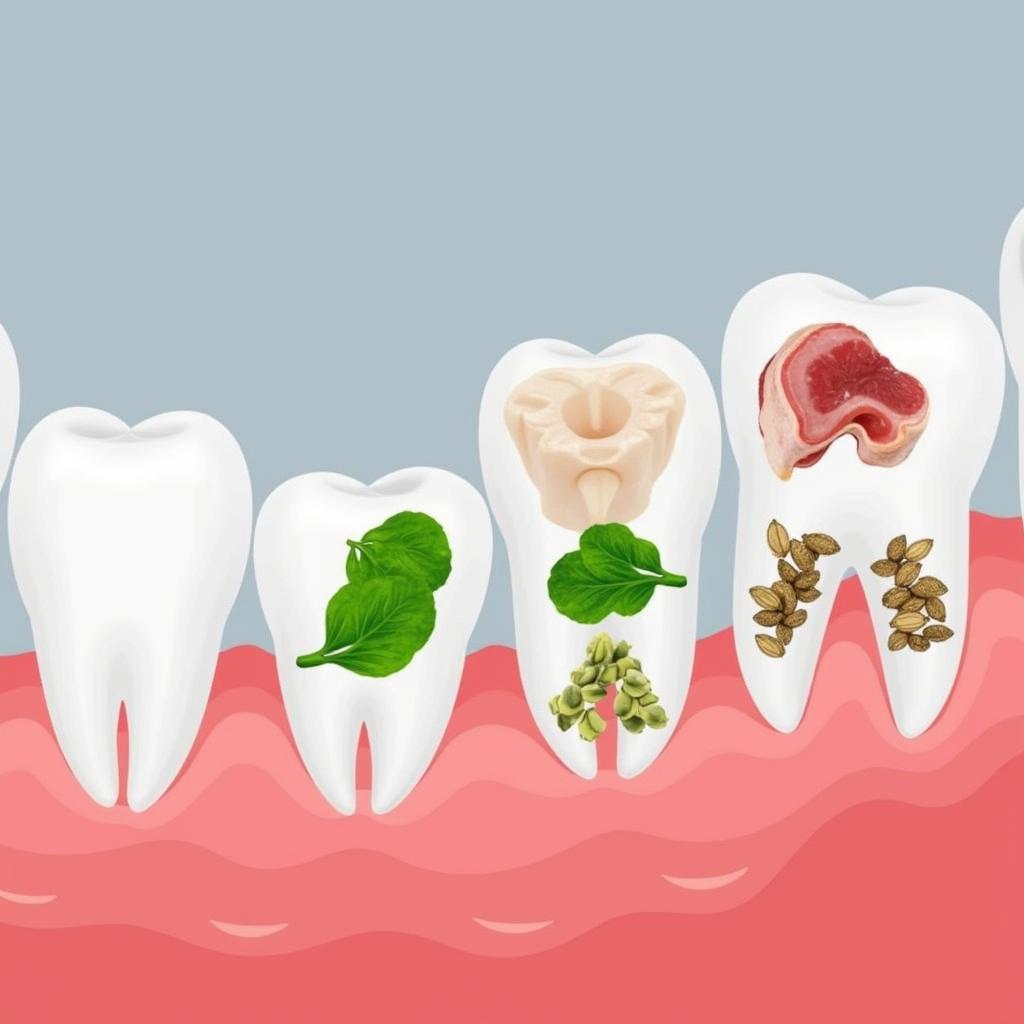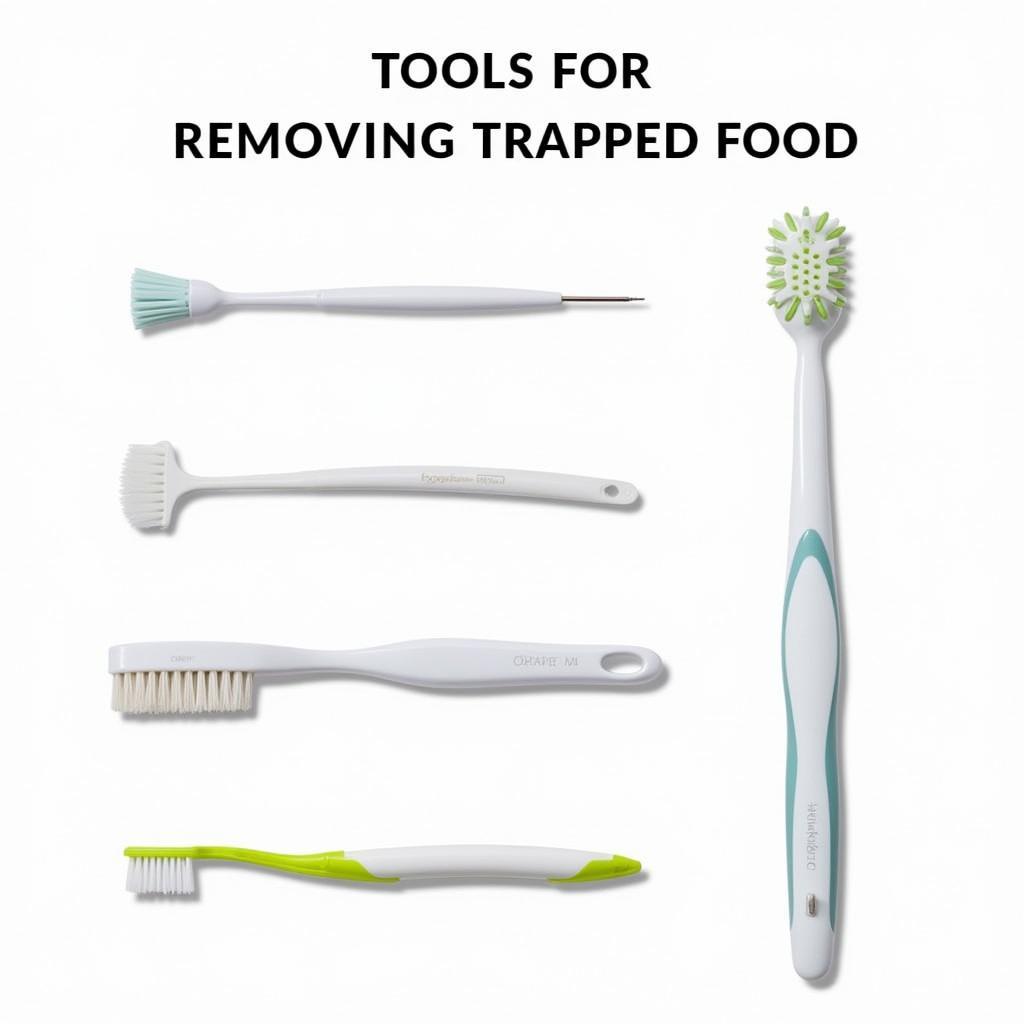Food trapped between your teeth is a common annoyance. It can range from a minor inconvenience to a source of real discomfort, even pain. This guide explores why food gets stuck, how to prevent it, and what to do when that pesky piece of spinach just won’t budge.
Have you ever been mid-conversation, only to realize a rogue piece of broccoli is wedged between your front teeth? Or worse, felt the sharp pang of pain from food lodged deep in your gums? If so, you know the struggle of “Food Trap Teeth.” This frustrating experience can disrupt meals, impact confidence, and even lead to more serious dental issues if left unchecked. This article will provide practical solutions and expert advice to help you navigate this common dental dilemma. Let’s delve into the world of trapped food and discover how to keep your smile bright and your teeth happy. You can learn how to remove stubborn food particles here: how to remove food stuck in wisdom tooth hole.
Why Does Food Get Stuck in My Teeth?
Several factors contribute to this common problem. Gaps or spacing between teeth are prime real estate for food particles. Crooked or misaligned teeth can also create traps. Dental work, such as fillings or crowns, can sometimes create uneven surfaces where food can easily become lodged. Even the natural shape and texture of certain foods can make them more likely to cling to your teeth.
Common Culprits and Their Hideouts
- Fibrous foods: Think spinach, kale, and stringy meats. These foods can easily get wedged between teeth, especially if there are gaps.
- Sticky foods: Caramel, taffy, and dried fruit are notorious for clinging to teeth and dental work.
- Seed-rich foods: Poppy seeds, sesame seeds, and even tiny strawberry seeds can find their way into those hard-to-reach spots.
- Hard foods: Popcorn kernels, nuts, and hard candies can chip or break teeth, creating new spaces for food to get trapped.
 Food Trapped Between Teeth: Various Food Particles Stuck in Teeth
Food Trapped Between Teeth: Various Food Particles Stuck in Teeth
Prevention is Key: Keeping Food Out in the First Place
While some food traps are unavoidable, many can be prevented with a few simple steps. Proper oral hygiene is essential. Brushing twice a day and flossing daily are the cornerstones of a healthy smile and a crucial defense against food trap teeth. Regular dental check-ups are also important to identify and address any underlying issues, such as cavities or gum disease, that can contribute to food getting stuck. Are you concerned about the safety of your enamel? Explore more about food safe enamel.
Tips for a Trap-Free Smile
- Brush and floss diligently: Focus on areas where food tends to get trapped.
- Rinse after meals: A quick swish with water or mouthwash can dislodge loose particles.
- Choose your foods wisely: Be mindful of the texture and stickiness of the foods you eat.
- Cut food into smaller pieces: This can make them easier to manage and less likely to get stuck.
- See your dentist regularly: Professional cleanings and check-ups can prevent problems before they start.
What to Do When Food Gets Stuck: Effective Removal Techniques
Even with the best preventative measures, food can still get stuck. Don’t panic! There are safe and effective ways to remove trapped food without damaging your teeth or gums. If your gums are sore, find more information on sore gums food stuck between teeth.
Safe Removal Methods
- Floss: This is your first line of defense. Gently guide the floss between your teeth, using a sawing motion to dislodge the food.
- Interdental brushes: These small brushes are designed to clean between teeth and can be especially helpful for those with braces or wider gaps.
- Waterpik or oral irrigator: These devices use a stream of water to flush out food particles.
- Toothpick: Use with caution! Avoid wooden toothpicks, which can splinter and get stuck themselves. Opt for plastic or rubber interdental picks, and be gentle to avoid injuring your gums.
“Regular flossing is paramount for maintaining oral hygiene and preventing food from getting trapped. It’s a simple yet powerful tool for preventing dental issues,” says Dr. Emily Carter, DDS, a renowned dental expert.
 Dental Floss and Interdental Brushes for Removing Trapped Food
Dental Floss and Interdental Brushes for Removing Trapped Food
Food Trap Teeth and Dental Implants: A Special Consideration
Dental implants are a fantastic solution for missing teeth, but they can also present unique challenges when it comes to trapped food. Wondering if food gets under dental implants? Find out more on does food get under dental implants. Regular cleaning and proper care are essential to maintaining the health of your implants and surrounding gums. Special floss and interdental brushes designed for implants can help reach those tricky areas.
“Dental implants require meticulous care, just like natural teeth. Proper cleaning techniques are crucial for their long-term success,” adds Dr. Carter.
When to Seek Professional Help
While most instances of food trap teeth can be handled at home, there are times when professional help is necessary. If you experience persistent pain, swelling, or bleeding, it’s essential to see a dentist. Experiencing pain? Learn more about food stuck in teeth pain. These could be signs of a more serious issue, such as an infection or abscess.
 Dentist Examining Patient's Teeth for Trapped Food and Dental Issues
Dentist Examining Patient's Teeth for Trapped Food and Dental Issues
Conclusion
Food trap teeth can be an annoying and sometimes painful problem. However, with proper prevention and removal techniques, you can keep your smile bright and your mouth healthy. Remember, regular brushing, flossing, and dental check-ups are your best allies in the fight against food trap teeth.
FAQ
- What is the best way to remove food stuck between teeth? Flossing is the most effective method.
- Can food trapped in teeth cause cavities? Yes, trapped food can contribute to plaque buildup and decay.
- Why does food get stuck in my teeth even after flossing? You might have gaps or misaligned teeth. Consult your dentist.
- Are there special tools for cleaning around dental implants? Yes, there are specialized floss and interdental brushes designed for implants.
- When should I see a dentist about food stuck in my teeth? If you experience persistent pain, swelling, or bleeding.
- What foods are most likely to get stuck in teeth? Fibrous, sticky, and seed-rich foods are common culprits.
- Can braces make food get stuck more easily? Yes, the brackets and wires of braces can create additional traps for food.
Common Scenarios
- Food stuck after a big meal: Try rinsing with water and flossing gently.
- Persistent pain from trapped food: See your dentist immediately, as this could indicate an infection.
- Food stuck under a crown: Try a waterpik or interdental brush. If the problem persists, contact your dentist.
Further Resources
For more information on related topics, you can explore our articles on wisdom tooth care and maintaining healthy gums.
For any assistance, please contact us at Phone Number: 02437655121, Email: minacones@gmail.com Or visit us at: 3PGH+8R9, ĐT70A, thôn Trung, Bắc Từ Liêm, Hà Nội, Việt Nam. We have a 24/7 customer service team.